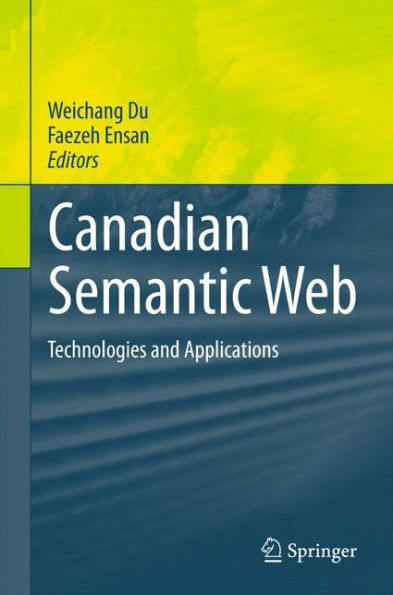Canadian Semantic Web: Technologies and Applications
The emergence of Web technologies for the distribution of an immense amount of data and knowledge has given rise to the need for supportive frameworks for kno- edge management. Semantic Web technologies aim at providing shared semantic spaces for Web contents, such that people, applications and communities can use a common platform to share information. Canadian Semantic Web: Technologies and Applications aims at contributing to the advancement of the Semantic Web by providing the most recent significant - search on Semantic Web theory, techniques and applications in academia, industry and government in Canada and all over the world. It also enlightens possible - mantic Web research directions in future by reporting some works in-progress that presenton-goingresearchonprinciplesandapplicationsof theSemanticWeb,while their implementation or deployment may have not been completed. This book consists of ten chapters. The chapters are extended versions of a - lected set of papers from the second Canadian Semantic Web Working Symposium (CSWWS 2009) and the twenty-first international Conference on Software En- neering and Knowledge Engineering (SEKE 2009). CSWWS 2009 was held in Kelowna, British Columbia in May 2009. Since many of the challenging aspects of the research problems tackled in the Semantic Web area fall in the realm of Ar-—cial Intelligence or employ of AI techniques, CSWWS 2009 was organized in - nd sociation with the 22 Canadian Conference on Artificial Intelligence.
1111328543
Canadian Semantic Web: Technologies and Applications
The emergence of Web technologies for the distribution of an immense amount of data and knowledge has given rise to the need for supportive frameworks for kno- edge management. Semantic Web technologies aim at providing shared semantic spaces for Web contents, such that people, applications and communities can use a common platform to share information. Canadian Semantic Web: Technologies and Applications aims at contributing to the advancement of the Semantic Web by providing the most recent significant - search on Semantic Web theory, techniques and applications in academia, industry and government in Canada and all over the world. It also enlightens possible - mantic Web research directions in future by reporting some works in-progress that presenton-goingresearchonprinciplesandapplicationsof theSemanticWeb,while their implementation or deployment may have not been completed. This book consists of ten chapters. The chapters are extended versions of a - lected set of papers from the second Canadian Semantic Web Working Symposium (CSWWS 2009) and the twenty-first international Conference on Software En- neering and Knowledge Engineering (SEKE 2009). CSWWS 2009 was held in Kelowna, British Columbia in May 2009. Since many of the challenging aspects of the research problems tackled in the Semantic Web area fall in the realm of Ar-—cial Intelligence or employ of AI techniques, CSWWS 2009 was organized in - nd sociation with the 22 Canadian Conference on Artificial Intelligence.
169.99
In Stock
5
1

Canadian Semantic Web: Technologies and Applications
217
Canadian Semantic Web: Technologies and Applications
217Hardcover(2010)
$169.99
169.99
In Stock

Product Details
| ISBN-13: | 9781441973344 |
|---|---|
| Publisher: | Springer US |
| Publication date: | 09/09/2010 |
| Edition description: | 2010 |
| Pages: | 217 |
| Product dimensions: | 6.10(w) x 9.25(h) x 0.02(d) |
From the B&N Reads Blog
